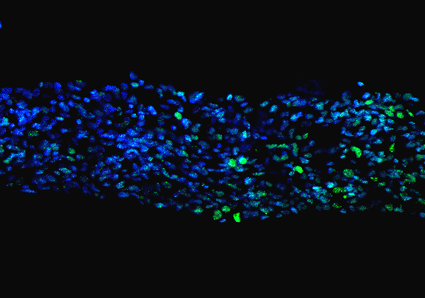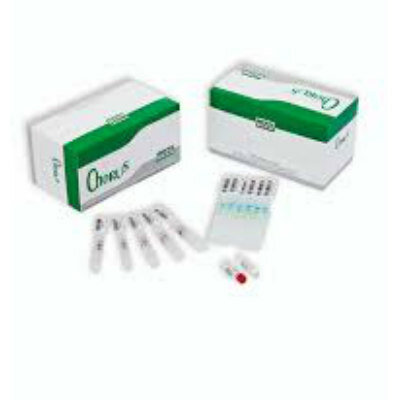Vital Human Tumor Tissue Samples Irradiated with Ions for the First Time
By LabMedica International staff writers
Posted on 20 Jan 2011
A team of German scientists' long-term goal is to enhance the already highly effective ion beam therapy in a way that allows the optimization of the irradiation dose based on the specific tumor of the individual patient. Such a treatment would constitute a novel approach, as radiation treatment so far only considered the type and position of the tumor.Posted on 20 Jan 2011
Cancer treatment with ion beams is characterized by an excellent cure rate with only minor side effects experienced by the patients. The therapy has been routinely in use for a little over one year. The effectiveness of the ion beams not only depends on the tumor type, but also on the genetic disposition and the personal circumstances of the individual patient.

Image: Tissue section of a human tumor sliced from a tissue culture. The tissue was cut in special process into thin slices and then stained with various dyes, (green: growing cells, blue: nuclei). (Photo courtesy Institute of Anatomy University of Leipzig / F. Merz).
For the first time, scientists from GSI Helmholtzzentrum für Schwerionenforschung (Darmstadt, Germany) have irradiated samples of vital human tumor tissue in the scope of their systematical and essential research. This research was only possible because the University of Frankfurt (Germany) was able to produce samples of specific human tumors for the first time. The patient-derived tumor tissue is prepared in a way that keeps the tissue sample vital for several weeks. The fact that these samples are consistent with their natural environment allows the scientists to observe the effects of the radiation that occur in the treatment of patients. One of the areas the researchers are studying is the so-called "bystander effect" -- the effect that the irradiated cells have on their neighboring cells. Earlier tests on artificial cell samples and animal experiments were very limited in this respect.
This cancer therapy developed at GSI has already proven to be highly effective, with very few side effects. "However, every tumor reacts differently to irradiation: some are more sensitive, stop growing or perish, others are more resistant and remain unaffected by the therapy. The effectiveness of the therapy varies from patient to patient," said Prof. Marco Durante, head of the biophysics department at GSI Helmholtzzentrum. "The irradiation and subsequent analysis of a tissue sample taken from the patient allows us to find out about the tumor's characteristics. And based on this knowledge, the attending physician can optimize the tumor therapy for the individual patient."
Human tissue samples are usually obtained during surgery. The new technique now makes it possible to keep those tissue samples vital in the laboratory over several weeks. "These so-called tissue slice cultures are used as a model system for biological studies, because they allow us to look beyond the events that occur in a single cell and help us study the tumor cells in their natural environment surrounded by other cells," explained Prof. Ingo Bechmann, who helped develop this new system at Charité in Berlin (Germany) and Frankfurt University. Dr. Kosta Schopow, the Frankfurt-based physician and curator of the Senckenberg Foundation, had the idea of using tissue slice cultures for the research at GSI.
The study's findings were published in the August 2010 issue of the journal Radiation and Environmental Biophysics.
Related Links:
GSI Helmholtzzentrum für Schwerionenforschung













